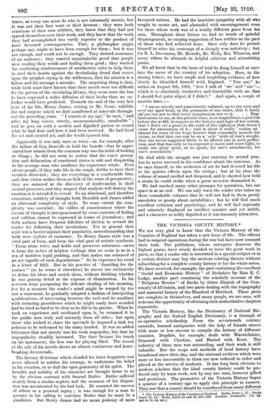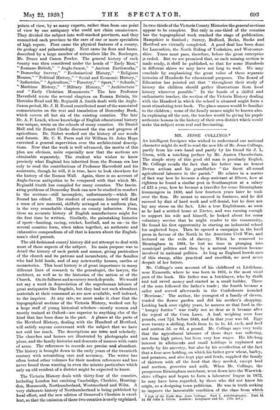THE VICTORIA COUNTY HISTORY.*
WE are very glad to know that the Victoria History of the Counties of England has taken a new lease of life. The editors had to suspend operations during the war but have now resumed their task. The publishers, whose enterprise deserves the highest praise, have wisely decided to issue the great work in parts, so that a reader who is interested in a special subject or in a certain district may buy the sections relating thereto without subscribing for a complete county history or for the whole series. We have received, for example, the part containing the excellent " Social and Economic History " of Berkshire by Miss E. C. Lodge, another part containing the scholarly account of the " Religious Houses " of Bucks. by Sister Elspeth of the Com- munity of All Saints, and two parts dealing with the topography and manorial history of the Hundred of Hertford. These parts are complete in themselves, and many people, we are sure, will welcome the opportunity of obtaining such authoritative chapters separately.
The Victoria History, like the Dictionary of National Bio- graphy and the Oxford English Dictionary, is a triumph of co-operatiie scholarship. From the seventeenth century onwards, learned antiquaries with the help of friends strove with more or less success to compile the history of different counties. Dugdale, for example, dealt with Warwickshire, Ormerod with Cheshire, and Hasted with Kent. The industry of these men was astounding, and their work is still valuable. But the scope and methods of local history have broadened since their day, and the national archives which were more or less inaccessible to them are now reduced to order and placed at the service of students. It has long been obvious to modern scholars that the ideal county history could be pro- duced only by team work, not by any one man, however gifted and persistent. The promoters of the Victoria History began a quarter of a century ago to apply this principle in earnest. They saw that a county should be considered from many different • The Victoria History of the Counties of England. Berks. Parts 1,124 Bucks Parts 10. 22 : Herts. Parts 13 and 15. 28a, 285. London: Constable. [Ss. 6d. net to Te. Gd. net.)
points of view, by as many experts, rather than from one point of view by one antiquary who could not claim omniscience. They divided the subject into well-marked provinces, and they committed each province to the care of one or more specialists of high repute. First came the physical features of a county, its geology and palaeontology. Next came its flora and fauna, described by a large number of naturalists like Dr. Boulenger, Mr. Druce and Canon Fowler. The general history of each county was then considered under the heads of " Early Man'," " Romano-British," " Anglo-Saxon," " Ancient Earthworks," " Domesday Survey," " Ecclesiastical History," " Religious Houses," " Political History," " Social and Economic History," `` Industries," " Agriculture," " Forestry," " Sport," " Schools," `` Maritime History," " Military History," "Architecture " and " Early Christian Monuments." The late Professor Haverfield wrote the several chapters on Roman Britain, Sir Hercules Read and Mr. Reginald A. Smith dealt with the Anglo- Saxon period, Mr. J. H. Round contributed most of the annotated commentaries on the text and translation of Domesday Book, which covers all but six of the existing counties. The late Mr. A. F. Leach, whose knowledge of English educational history was unique, wrote on the schools of many counties. Sir Daniel Hall and Sir Ernest Clarke discussed the rise and progress of agriculture. Dr. Nisbet worked out the history of our woods and forests. Mr. C. R. Peers and Sir William St. John Hope exercised a general supervision over the architectural descrip- tions. Now that the work is well advanced, the merits of this plan are obvious, mere especially now that the sections are obtainable separately. The student who wishes to know precisely what England has inherited from the Roman era has only to read the contributions of Professor Haverfield and his assistants, though he will, it is true, have to look elsewhere for the history of the Roman Wall. Again, there is no account of Anglo-Saxon antiquities to be compared with that which Mr. Reginald Smith has compiled for many counties. The fascin- ating problems of Domesday Book can now be studied in comfort in the sections—still incomplete, unfortunately—which Mr. Round has edited. The student of economic history will find a mass of new material, skilfully arranged on a uniform plan, in the very remarkable chapters on county industries. From these an accurate history of English manufactures might for the first time be written. Similarly, the painstaking histories of sport—hunting, racing, cricket, football, and so on—in the several counties form, when taken together, an authentic and exhaustive compendium of all that is known about the English- man's chief pursuit.
The old-fashioned county history did not attempt to deal with most of these aspects of the subject. Its main purpose was to detail the history of each parish and manor, giving particulars of the church and its patrons and incumbents, of the families who had held lands, and of any noteworthy houses, castles or monasteries. This local history is of great importance in many different lines of research to the genealogist, the lawyer, the architect., as well as to the historian of the nation or of the Church. On its fullness and accuracy much depends. We would not say a word in depreciation of the superhuman labours of great antiquaries like Dugdale, but they had not such abundant materials at their command as are now available, well indexed, to the inquirer. At any rate, we must make it clear that the topographical sections of the Victoria History, worked out by a large staff of young historical scholars—mostly women and mostly trained at Oxford—are superior to anything else of the kind that has been done in the past. A glance at the parts of the Hertford History, dealing with the Hundred of Hertford, will satisfy anyone conversant with the subject that we have not said too much. The descriptions are terse and scholarly. The churches and houses are illustrated by photographs and plans, and the family histories and descents of manors with coats of arms. The references to records are precise and• abundant. The history is brought down to the early years of the twentieth century with astonishing care and accuracy. The writer has often tested other volumes for their modern references and has never found them wanting in even the minute particulars which only an old resident of a district might be expected to know.
The Victoria History deals with thirty-four of the counties, including London but omitting Cambridge, Cheshire, Hunting. don, Monmouth, Northumberland, Westmorland and Wilts. A very elaborate history of Northumberland is being published by local effort, and the new edition of Ormerod's Cheshire is excel- lent, so that the omission of these two counties is easily explained. In two-thirds of the Victoria County Histories the general sections appear to be complete. But only in one-third of the counties has the topographical work reached the stage of publication. Hampshire is finished ; Surrey, Bedford, Berks, Bucks and Hertford are virtually completed. A good deal has been dono for Lancashire, the North Riding of Yorkshire, and Worcester- shire. Years must pass, therefore, before the great enterprise is ended. But we are promised that, as each missing section is made ready, it shall be published, so that for some Hundreds in different shires we may have not long to wait. We may conclude by emphasizing the great value of these separate histories of Hundreds for educational purposes. The Board of Education has pointed out that " throughout their study of history the children should gather illustrations from local history wherever possible." In the hands of a skilful and enthusiastic teacher, the section of the Victoria History dealing with the Hundred in which the school is situated might form a most stimulating text-book. The place-names would be familiar to the children ; some of the family names might be known also. In explaining all the rest, the teacher would be giving his pupils authentic lessons in the history of their own district which would make the subject seem real and fascinating.



































 Previous page
Previous page